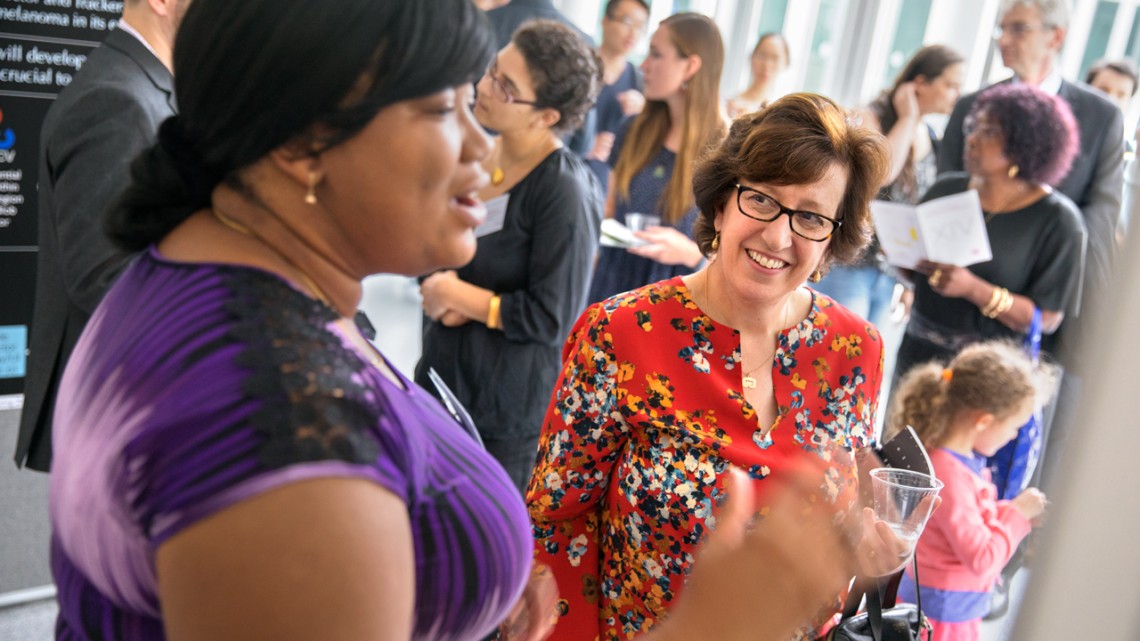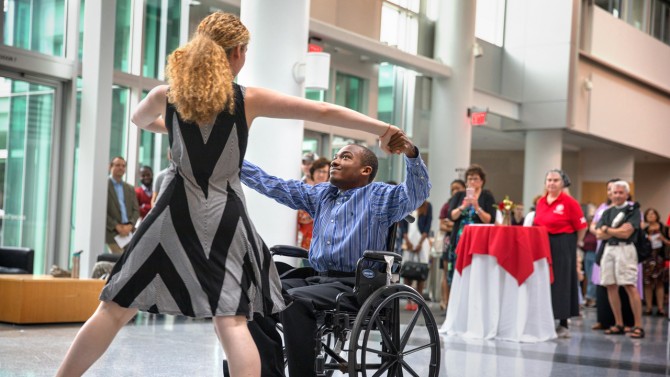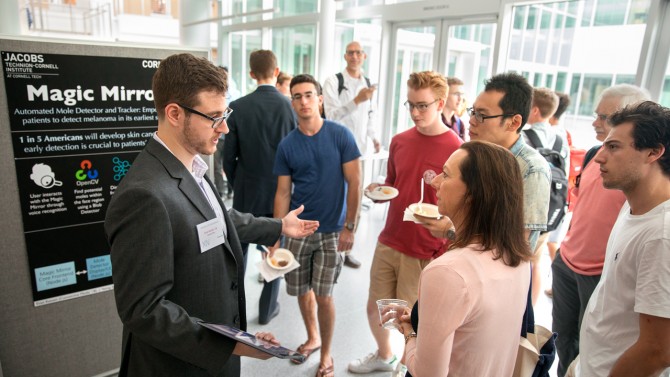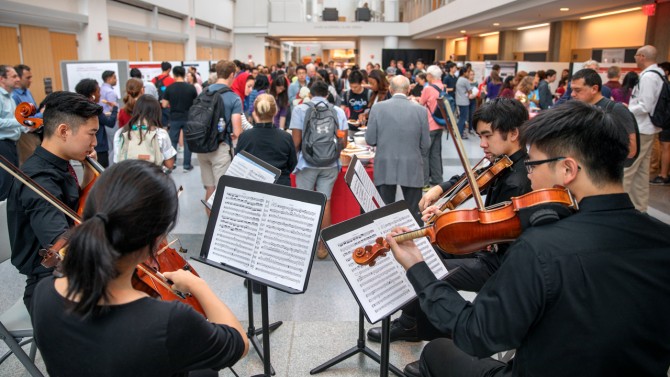
President Martha E. Pollack visits with Dainelle Allen ’18, a student presenter, during the Festival of Scholarship, Aug. 24 in the Physical Sciences Building Atrium. The festival kicked off three days of events that include the Aug. 25 inauguration of Pollack as Cornell’s 14th president.
Inauguration kicks off with research on display at Festival of Scholarship
By Tom Fleischman
More than 30 project teams involving undergraduate, graduate and professional students presented posters and answered questions from curious attendees during the Festival of Scholarship, part of the two-day celebration of the inauguration of Martha E. Pollack as Cornell University’s 14th president. The festival was held Aug. 24 in the Physical Sciences Building Atrium.
Among the curious was the president herself, who mingled and conversed with the student presenters during the 90-minute event.
All corners of Cornell were represented, including Weill Cornell Medicine, whose representative, Sydney Ariagno, M.D. ’18, has been working on a noninvasive way to detect medulloblastoma, the most common malignant pediatric brain tumor. More than one-third of affected children die within five years of diagnosis.
“A big problem with this disease is that, in order to study the tumor, we have to do invasive procedures, like a biopsy,” Ariagno said. “We’re trying to develop a blood test to detect and monitor this disease.”
Sam Whitehead, Ph.D. ’19, presented “Teaching a Mouse to Use a Joystick: Understanding the Neural Basis for Movement.” The goal of his work, he said, is greater understanding of the mammalian motor system, “which is some sort of holy grail of neuroscience.”
The mouse brain is well-suited for study, Whitehead said, because of its size and the ability to target different subpopulations of neurons within and manipulate them. “We want to take mice, which have all these advantages in terms of genetics,” he said, “and teach them a task that has a lot of complexity, and basically train these mice to use the joystick to perform these complex tasks.”
Ethan Anderson ’18 leads a group focused on “Bargaining for Better Schools.” The group compiling a clearinghouse of information on collective-bargaining agreements for public-school teachers from districts across New York state. The information features statistical analysis of data collected from more than 600 contracts.
“The objective of the project is just to make the information more available,” Anderson said.
Another presenter, Tauhidur Rahman, Ph.D. ’17, along with adviser Tanzeem Choudhury, associate professor in information science, has developed DoppleSleep, a sensor that uses short-range Doppler radar to detect motion, heartbeat and breathing during sleep. Their technology offers a more realistic sleep experience during study than the best current technology, he said.
“If a sleep expert has a suspicion that something is going wrong in your sleep,” Rahman said, “they will send you to a sleep lab and make you wear a bunch of sensors and electrodes and ask you to sleep, which is not a fun experience.”
Rahman was one of the first presenters Pollack visited.
“It was awesome; the president was really friendly and cordial, and asked a lot of questions,” Rahman said. “She actually knows my adviser fairly well, and I felt really connected with the president.”
In addition to Weill Cornell Medicine, Cornell’s growing New York City presence was represented by Cornell Tech. Evan Kesten ’18, a master’s student in connective media, presented his project, the Magic Mirror – a camera, mounted into a mirror, that uses computer vision and machine learning to track changes in moles on the user’s face or upper body.
“It would first detect moles,” Kesten said, “and then use facial modeling to piece those images together, and with each visit to the mirror you can track the growth of every mole or anomaly.”
A total of 36 groups presented at the event; other projects addressed gene editing, young females’ perception of rejection, land conservation and ecotourism, pediatric cancer research, and a way for parents could better understand the developmental benefits of children’s play.
Midway through the event, there was a wheelchair ballroom dancing demonstration by Nicole Agaronnik ’20 and her partner, Tai Robert Penn ’20, who uses a wheelchair. They moved gracefully to Adele’s “One and Only” as Pollack – who visited with the pair before and after their performance – looked on.
The festival offered an opportunity for all attendees – including the presenters themselves – to see what kind of work is being done across campus.
“It’s nice to have a space where I get to see the other kind of work that’s being done here,” said Shruti Sannon, Ph.D. ’20, whose group presented a project, “Invisible Chronic Illnesses on Social Media,” which examined how social media can serve as a platform for people with invisible chronic illnesses to obtain social support and promote community-building. “I also hope to get feedback from a lot of people doing very different but exciting things.”
Media Contact
Get Cornell news delivered right to your inbox.
Subscribe

